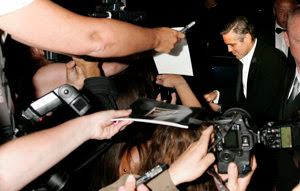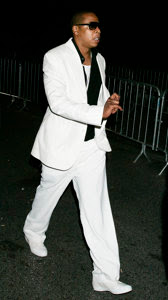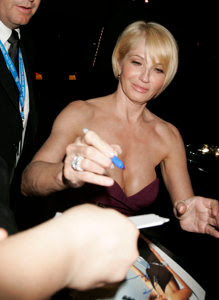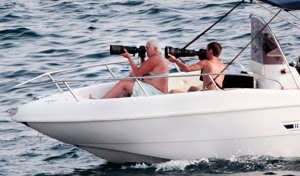 Cannes- The core of the Cannes Film Festival is about buying and selling films. The red carpet, the lavish parties, and the photocalls get all the attention. The real business of movie making is when producers and distributors get together and make deals.
Cannes- The core of the Cannes Film Festival is about buying and selling films. The red carpet, the lavish parties, and the photocalls get all the attention. The real business of movie making is when producers and distributors get together and make deals.
At Cannes, buyers and seller from all over the world convene in a marketplace that help facilitate transactions. Everyone in the world needs to fill up their programming schedule. If you have a film, there is someone who will be buy it, at the right price.
Cannes is the two-week Wall Street of the film world. Most of the public really doesn't care about deals. They want the inside info on the movie stars.
Some of the stars understand Cannes as the marketplace and come to promote their project. Others think Cannes is one huge party. Those are the ones that get in trouble with photographers and gossip mongers. 
The photographic landscape that is Cannes is broken up into several areas if your looking to take photos of celebs.
First and foremost is the official premieres and photocalls that Cannes organizes. Photographers are required black-tie apparel to shoot the premieres on the steps of the Festival des Palais. Usually in the morning of the premiere the festival organizes a photocall, a less formal event with casual attire.
At night, there is an after-party for the film that is also black-tie. That gives official press photographers three chances to shoot the stars of a film. With over 200 photographers at each event, the film and its actors get a lot of carefully controlled exposure.
The real photos are taken at the other, unofficial areas of Cannes that make up the paparazzi landscape. First there is the street. Many times an actor has to run through a gauntlet of photographers and fans to go from their car to a party.
fans to go from their car to a party.
Anything can happen and photographers hope something will. Sometimes you'll see a less well known celeb walking the streets unnoticed.
Somewhat easier is the yacht parties. Multi-million dollar yachts are docked right next to the Palais and every night someone hosts a party the celebs go to. Some are easy to spot. Robert Cavalli had his yacht with his intials on the bow where Sharon Stone stayed while she was in Cannes. You could see her on deck from the dock.
Jessica Simpson went to a yacht party sponsored by Budweiser. The pier where all these yachts are docked are in public areas where anyone can walk and rub elbows with celebs. The thing is that most of the public was unaware of it and hung out at the big premieres on the steps of the Palais.
Another watering hole for celebs were the nightclubs that spring up during the festival. They are situated in Palm Beach, about 2km from the Palais. The VIP Room is a loud tecno disco where a few celebs like Kylie Minogue and Dita Von Teese hung out into the wee hours of the morning.
The cast of Oceans 13 and the fashion house of Dolce & Gabbana held parties at Baole in the area. Celebs flocked to the D&G party as they were giving out free sunglasses, which retail in the $400 range. I saw Edge from U2, Naomi Campbell, Robert Rodriguez and his new girlfriend, Rose McGowan, Michelle Rodriguez and Jay Z among others leaving that party.
The photographers who were looking for the big score rented boats or sat on a jetty overlooking the Hotel du Cap in Eden Roc. The hotel is where the cast of Oceans 13 stayed. So if you wanted photos of Brad Pitt, Angelina Jolie, George Clooney, Andy Garcia, Don Cheadle, Ellen Barkin or Matt Damon, you had to stake the place out. The place is pretty well known by the paparazzi and they are in plain site so when a celeb gets there photo taken on the beach there, they are either really naive because its there first time there or hoping someone will take their photo and gain some publicity. I think its mostly the latter.
A few more random things about Cannes. An Amercain sandwich has french fries in it. Why  do the French think Americans love french fries so much that we put them in out sandwich? We, of course don't. McDonalds is so anti-french in its food philosophy but hordes of kids flock to it at Cannes. The food there is not the same in the states, the meat patty is smaller, the bun has herbs, the mustard is dijon.
do the French think Americans love french fries so much that we put them in out sandwich? We, of course don't. McDonalds is so anti-french in its food philosophy but hordes of kids flock to it at Cannes. The food there is not the same in the states, the meat patty is smaller, the bun has herbs, the mustard is dijon.
Even though its called fast-food, everyone in France doesn't work fast, expect a little longer for everything.
The supermarket in France has a whole aisle devoted to yogurt. I guess the French love yogurt. You can't get cheddar cheese in France, so don't ask. In a restaurant, the bottled water cost as much or more than anything else, about 6 eur or about $8 for a liter of Evian, more expensive than the beer or wine. They will ask if you want water, you think you are getting regular tap water, but you getting the most expensive water in the world. You can ask for tap water, sometimes they will give you it, sometimes they will not understand, or pretend not to understand. Tap water is drinkable in France.
In general the food is much better than in the US but because of the weak dollar, you will pay for it.
The thing that surprised me the most was how backwards technological France is. The internet is really slow, I have yet to pass by a store that sold computers and plasma TV's. Maybe things are different in a big city like Paris, by Cannes is like the US in 1998.
Its not that they don't have anything you can get in the US, it is just not as widespread. You see people with digital cameras, ipods and laptops, but only rarely. I guess they are too busy smoking cigarettes and hanging out in cafes, which is a stereotype but somewhat based in fact.
 Sunday, March 1, 2009 at 1:07AM
Sunday, March 1, 2009 at 1:07AM 












